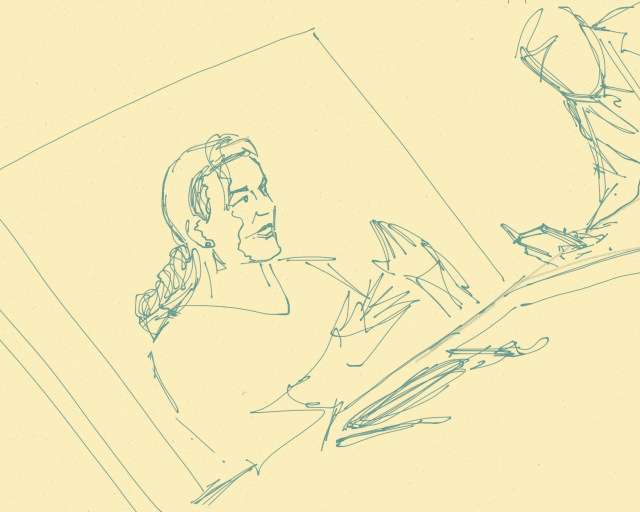If Facebook offered passports, most Somalis would now be living in Facebook

UK ambassador to Somalia, Harriet Mathews, during the Eat &Tweet event
‘If Facebook offered passports, most Somalis would now be living in Facebook,’ says Fatuma Abdulahi, the editor of the popular Somalia-focussed website, Wariye Post.
She is right: Somalis have taken to social media with even more enthusiasm than the rest of the (connected) planet, and not just to share selfies or pictures of cats.
‘Everyone has heard about the oral culture of the Somalis, that we didn’t have an agreed written form of the language until the 70s,’ she continues, ‘but what isn’t mentioned is that the oral culture left out women, young people and minority groups: social media now offers those groups a voice.’
And there are plenty of those voices around the table at the British Embassy in Mogadishu for an ‘Eat & Tweet’ hosted by the new ambassador, Harriet Mathews. ‘Only one ‘t’ in Mathews, otherwise you won’t find me on Twitter and someone else will be getting bombarded with hashtags,’ she notes.
There are journalists (Radio Goobjoog, Mogadishu News, Radio Dalsan, CCTV Africa), a rep from the National Union of Somali Journalists and media activists like Idilay Bilan. All are young: this seems to be a young man’s – and woman’s – game. Others couldn’t make it today but will hopefully be included in future Eat & Tweets: the phenomenally popular Canadian-Somali Instagramer, Ugaaso Abukar Boocow; the photographer behind ‘@MogadishuImages’ who is sharing the raw beauty of Mogadishu every day; and many, many more. The event even has its own hashtag: #Media4Somalia and the participants are encouraged to Tweet as they eat, like the name says.
It’s not long before comments are coming in: ‘what’s on the menu? Hilib geel [camel meat] or curry?’ asks Dahir Kulane, a popular Twitterer who could not make the event. (It’s chicken curry. It is the British Embassy, after all.)
But Somalis don’t generally spend their time on social media sharing photos of their lunch: they have more important issues to discuss. So the camera does NOT, on this occasion, eat first.
‘The incident in Marka, that’s the biggest story right now,’ notes the Radio Goobjoog correspondent, referring to the killing of members of a wedding party by African Union soldiers, apparently in reprisal for a roadside bomb attack on their convoy. ‘The people took to social media to vent their anger. There isn’t anywhere else for them to go with their anger.’
‘Except al-Shabaab,’ says another participant.
‘But al-Shabaab banned 3G. We know what al-Shabaab is all about these days. They’re good at social media in that they’re fast, and much better than the government, but everyone knows what their agenda is these days.’
‘The government is getting better, though.’ There is some agreement. ‘The Ministry of Security, NISA [the National Intelligence & Security Agency], they are getting much faster in telling the people what is happening during attacks.’ (Although they get hell from some quarters for their trouble, and compared to the scandal-seeking local channel, Shabelle.)
The discussion widens onto the challenges facing governments in the information age: the need to tell the truth (if there is such a thing anymore), keeping up with the pace of digital media, the need to be interactive and the sheer risk that is implicit in every Tweet, every photo posted, every blog.
‘We’re in a period of time where fear dominates all our editorial judgements,’ notes the ambassador. She recounts the challenges the UK experiences: despite being the third largest donor in Somalia after the US and the EU, the natural British reserve and humility (and, of course, concerns about security) has led the UK to be cautious in publicising its direct support to the Federal Government and across Somalia as a whole. The obvious comparison with the more overt self-publicity of Turkey in Somalia prompts more discussion.
But the consensus is that governments and institutions can do it, it will just take time to change institutionalised mindsets. (At this point, Faduma and Idilay recount their experiences training government personnel in social media, with the caveat, ‘don’t Tweet this!’ – it’s the only one of the day. There is still some way to go, apparently, but they are making progress.)
Flipping the discussion, the ambassador asks (on Twitter first, then to the group), what can governments and institutions do to help the Fourth and Fifth Estates? Resist the temptation to try to bring them into the institutional fold is a view that comes across strongly. Leave independent voices just as they are: independent.
Create more space seems to be another strong message. What does that mean, saturate the city with free wifi, give out cheap Smart phones? No, apparently. It means creating real, physical spaces for expression, like sports grounds, arts venues.
But, yes, free wifi would be nice as well. (Although even this brings with it an implicit risk: the participants account for the significant numbers of Somali and others trying to migrate elsewhere as being linked to the world they have been introduced to through social media.)
The other constraint that faces governments and institutions intervenes: time. But Eat & Tweet becomes Walk & Talk and the subject of access comes up: the Eat & Tweet started late because the airport complex, where the British Embassy is located, ‘might as well be in another country’ (because of the security restrictions – particularly for Somalis).
‘Next time we should meet in the city,’ suggests one participant, causing the security officer to blanch. But the ambassador doesn’t seem disinclined to the idea.
